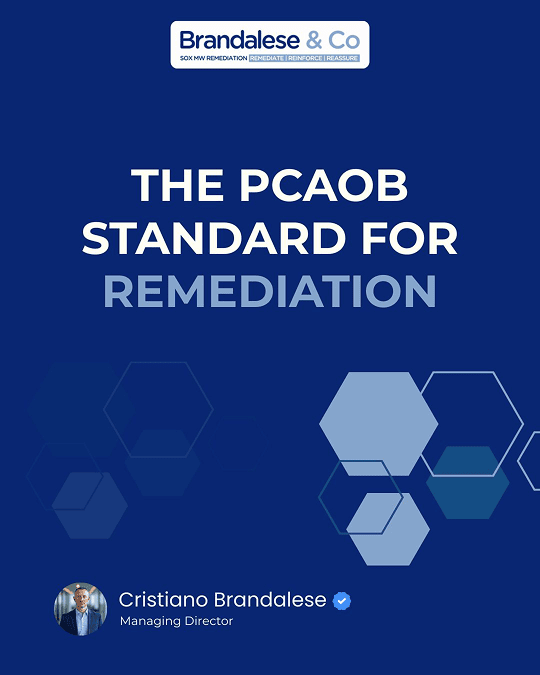When a company identifies a material weakness (MW) in its internal control over financial reporting (ICFR), the stakes couldn’t be higher. Not only does a material weakness undermine investor confidence, but it also puts management’s credibility and the organization’s financial integrity on the line.
That’s where the Public Company Accounting Oversight Board (PCAOB) comes in. The PCAOB has established clear standards that guide how companies must remediate material weaknesses. And here’s the key: remediation isn’t simply about fixing the problem on paper. It’s about proving that the fix works, that it holds up under scrutiny, and that it sustains reliability over time.
In short, remediation isn’t a patch—it’s a process of building lasting effectiveness.
What the PCAOB Requires
According to PCAOB standards, management must go far beyond surface-level fixes. The framework emphasizes sustainability and verifiability. Specifically, companies must demonstrate that:
⦁ The deficiency is corrected.
It’s not enough to document a new control or policy. The control must directly address the root cause of the weakness.
⦁ The control works reliably over time.
Auditors and regulators expect to see evidence that the control isn’t just working today but continues to operate as designed.
⦁ Effectiveness is proven and documented.
Documentation must clearly demonstrate how the control operates, who owns it, and how management monitors it. Proof is not optional—it’s required.
This three-part expectation transforms remediation from a “check-the-box” exercise into a rigorous, evidence-driven process.
Management’s Responsibility vs. Auditor’s Role
One of the most common misconceptions in MW remediation is who actually “owns” the process. PCAOB standards make this distinction clear:
⦁ Management is responsible for identifying, correcting, and demonstrating the effectiveness of remediation efforts. This includes designing, implementing, and monitoring new or revised controls.
⦁ Auditors review and test the remediation to validate its effectiveness. They confirm that management’s solution works, but they do not design or lead the remediation effort.
This is an important boundary. If management expects auditors to take the lead, remediation will fail to meet PCAOB expectations. Ownership sits squarely with management—and only those with the right expertise can ensure success.
Why Expertise Matters in Remediation
Many organizations fall into the trap of treating remediation like a compliance exercise—check the box, file the paperwork, and move on. But remediation is much more than that.
The reality is that remediation must withstand scrutiny from auditors, regulators, and investors. Controls that are hastily designed, poorly implemented, or inadequately documented often crumble when tested. This not only prolongs the remediation process but can also result in repeat findings, further eroding stakeholder confidence.
Expertise makes the difference between fragile, temporary fixes and durable, sustainable solutions. Experienced leaders understand how to:
⦁ Pinpoint root causes. Instead of layering on redundant controls, they identify what truly needs to change.
⦁ Integrate remediation into the business. Controls should enhance workflows, not disrupt them.
⦁ Design for sustainability. Effective controls balance rigor with practicality, ensuring they survive over time.
Without seasoned judgment, organizations risk investing in solutions that look good on paper but fail under audit.
The Leadership Factor: Why Senior Involvement Is Critical
Remediation is not a task for junior staff or even mid-level resources working in isolation. It requires leadership, judgment, and influence. Here’s why senior involvement is critical:
⦁ Identifying the right controls.
Choosing the wrong control—or adding unnecessary complexity—can waste resources and fail to address the issue. Leaders bring the perspective to select controls that are both effective and feasible.
⦁ Securing buy-in from control owners.
Even the best-designed control will fail if the people responsible for executing it don’t buy into the change. Experienced leaders know how to communicate with stakeholders, gain commitment, and build accountability.
⦁ Designing sustainable fixes.
Controls can’t be one-off solutions. They must work consistently within the organization’s existing structure, resources, and culture. Leaders design fixes that last.
⦁ Educating and aligning with auditors.
PCAOB standards require documentation that auditors can tie back to compliance expectations. Senior leaders ensure auditors understand not only what was fixed but also why it will continue to work.
This leadership factor is the difference between remediation that fails under audit and remediation that inspires confidence in all stakeholders.
The Cost of Getting It Wrong
When remediation is treated as a quick patch or delegated to junior staff without sufficient oversight, the risks are significant:
⦁ Repeat findings. Ineffective remediation leads to recurring material weaknesses, compounding reputational and compliance risks.
⦁ Audit pushback. Auditors are unlikely to sign off on remediation that lacks depth, documentation, or sustainability.
⦁ Wasted resources. Companies may spend heavily on controls that don’t address root causes or are impossible to maintain.
⦁ Delayed closure. Instead of resolving the issue efficiently, poor remediation drags out the process—sometimes for years.
The stakes are too high for shortcuts. Effective remediation requires investment in experience and leadership from the start.
Building Remediation That Lasts
So how can companies ensure that remediation efforts not only pass audit but also strengthen ICFR for the long term? The roadmap starts with these steps:
⦁ Conduct a root cause analysis. Don’t just fix the symptom. Understand the underlying issue.
⦁ Design feasible, sustainable controls. Controls must be realistic given the company’s structure and resources.
⦁ Assign clear ownership. Every control should have a defined owner responsible for execution and monitoring.
⦁ Educate and train stakeholders. Control owners need to understand the purpose, execution, and importance of the fix.
⦁ Document thoroughly. Tie all remediation efforts back to PCAOB standards with clear, audit-ready documentation.
⦁ Monitor continuously. Effective remediation is ongoing—controls must be tested, refined, and reinforced over time.
With this approach, companies transform remediation from a compliance burden into a foundation for stronger governance.
Final Thoughts: Why Shortcuts Don’t Work
The PCAOB standard for remediation is clear: it’s not enough to fix a control—you must prove it works, document it, and sustain it over time. That takes leadership, experience, and discipline.
Material weakness remediation is one of the most high-stakes areas of SOX compliance. Done right, it strengthens investor confidence, accelerates audit closure, and sets the stage for future resilience. Done wrong, it can cost time, money, and credibility.



